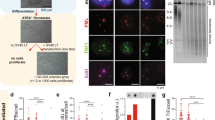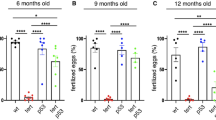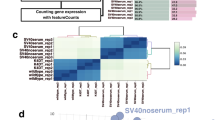Abstract
Expression of the human telomerase catalytic component, hTERT, in normal human somatic cells can reconstitute telomerase activity and extend their replicative lifespan1,2. We report here that at twice the normal number of population doublings, telomerase-expressing human skin fibroblasts (BJ-hTERT) and retinal pigment epithelial cells (RPE-hTERT) retain normal growth control in response to serum deprivation, high cell density, G1 or G2 phase blockers and spindle inhibitors. In addition, we observed no cell growth in soft agar and detected no tumour formation in vivo. Thus, we find that telomerase expression in normal cells does not appear to induce changes associated with a malignant phenotype.
This is a preview of subscription content, access via your institution
Access options
Subscribe to this journal
Receive 12 print issues and online access
$209.00 per year
only $17.42 per issue
Buy this article
- Purchase on Springer Link
- Instant access to full article PDF
Prices may be subject to local taxes which are calculated during checkout




Similar content being viewed by others
References
Bodnar, A.G. et al. Extension of life-span by introduction of telomerase into normal human cells. Science 279, 349– 352 (1998).
Weinrich, S.L. et al. Reconstitution of human telomerase with the template RNA component hTR and the catalytic protein subunit hTRT. Nature Genet. 17, 498–502 (1997).
McKay, B.S. & Burke, J.M. Separation of phenotypically distinct subpopulations of cultured human retinal pigment epithelial cells. Exp. Cell Res. 213, 85–92 (1994).
Weinberg, R.A. The retinoblastoma protein and cell cycle control. Cell 81, 323–330 (1995).
Alcorta, D.A. et al. Involvement of the cyclin-dependent kinase inhibitor p16 (INK4a) in replicative senescence of normal human fibroblasts. Proc. Natl Acad. Sci. USA 93, 13742–13747 (1996).
Linke, S.P., Clarkin, K.C., Di Leonardo, A., Tsou, A. & Wahl, G.M. A reversible, p53-dependent G0/G1 cell cycle arrest induced by ribonucleotide depletion in the absence of detectable DNA damage. Genes Dev. 10, 934– 947 (1996).
Pedrali-Noy, G. et al. Synchronization of HeLa cell cultures by inhibition of DNA polymerase α with aphidicolin. Nucleic Acids Res. 8, 377–387 (1980).
White, A.E., Livanos, E.M. & Tlsty, T.D. Differential disruption of genomic integrity and cell cycle regulation in normal human fibroblasts by the HPV oncoproteins. Genes Dev. 8, 666–677 ( 1994).
Yin, Y., Tainsky, M.A., Bischoff, F.Z., Strong, L.C. & Wahl, G.M. Wild-type p53 restores cell cycle control and inhibits gene amplification in cells with mutant p53 alleles. Cell 70, 937–948 (1992).
Livingstone, L.R. et al. Altered cell cycle arrest and gene amplification potential accompany loss of wild-type p53. Cell 70, 923–935 (1992).
Schwartz, D., Almog, N., Peled, A., Goldfinger, N. & Rotter, V. Role of wild type p53 in the G2 phase: regulation of the γ-irradiation-induced delay and DNA repair. Oncogene 15, 2597–2607 ( 1997).
Khan, S.H. & Wahl, G.M. p53 and pRb prevent rereplication in response to microtubule inhibitors by mediating a reversible G1 arrest. Cancer Res. 58, 396–401 (1998).
Gualberto, A., Aldape, K., Kozakiewicz, K. & Tlsty, T.D. An oncogenic form of p53 confers a dominant, gain-of-function phenotype that disrupts spindle checkpoint control. Proc. Natl Acad. Sci. USA 95, 5166–5171 ( 1998).
Freedman, V.H. & Shin, S.I. Cellular tumorigenicity in nude mice: correlation with cell growth in semi-solid medium. Cell 3, 355–359 ( 1974).
Shin, S., Freedman, V.H., Risser, R. & Pollack, R. Tumorigenicity of virus-transformed cells in nude mice is correlated specifically with anchorage independent growth in vitro. Proc. Natl Acad. Sci. USA 72, 4435–4439 ( 1975).
Saksela, E. & Moorhead, P.S. Aneuploidy in the degenerative phase of serial cultivation of human cell strains. Genetics 50, 390–395 (1963).
Benn, P.A. Specific chromosome aberrations in senescent fibroblast cell lines derived from human embryos. Am. J. Hum. Genet. 28, 465–473 (1976).
Johnson, T.E. et al. Karyotypic and phenotypic changes during in vitro aging of human endothelial cells. J. Cell Physiol. 150, 17–27 (1992).
Lee, H.W. et al. Essential role of mouse telomerase in highly proliferative organs. Nature 92, 569– 574 (1998).
Wright, W.E., Piatyszek, M.A., Rainey, W.E., Byrd, W. & Shay, J.W. Telomerase activity in human germline and embryonic tissues and cells. Dev. Genet. 18, 173–179 (1996).
Chiu, C.P. et al. Differential expression of telomerase activity in hematopoietic progenitors from adult human bone marrow. Stem Cells 14, 239–248 (1996).
Mullen, P., Ritchie, A., Langdon, S.P. & Miller, W.R. Effect of matrigel on the tumorigenicity of human breast and ovarian carcinoma cell lines. Int. J. Cancer 67, 816– 820 (1996).
Noel, A. et al. Enhancement of tumorigenicity of human breast adenocarcinoma cells in nude mice by matrigel and fibroblasts. Br. J. Cancer 68, 909–915 (1993).
Acknowledgements
We thank C. Harley and T. Okarma for critical reading of the manuscript and A. Bronstein and S. Starr for expert technical assistance. G.J. is supported by a postdoctoral fellowship from NIH. G.M.W. and M.B. are supported by grants from the NIH (CA 61449) and the G. Harold and Leila Y. Mathers Charitable Foundation. T.D.T. and M.S. are supported by grants from the NIH (CA 42765, CA 51912 and CA 58207).
Author information
Authors and Affiliations
Corresponding author
Rights and permissions
About this article
Cite this article
Jiang, XR., Jimenez, G., Chang, E. et al. Telomerase expression in human somatic cells does not induce changes associated with a transformed phenotype. Nat Genet 21, 111–114 (1999). https://doi.org/10.1038/5056
Received:
Accepted:
Issue Date:
DOI: https://doi.org/10.1038/5056
This article is cited by
-
A robust reprogramming strategy for generating hepatocyte-like cells usable in pharmaco-toxicological studies
Stem Cell Research & Therapy (2023)
-
The other side of the coin: mesenchymal stromal cell immortalization beyond evasion of senescence
Human Cell (2023)
-
CREB signaling activity correlates with differentiation and survival in medulloblastoma
Scientific Reports (2021)
-
Cryo-EM structures tell a tale of two telomerases
Nature Structural & Molecular Biology (2021)
-
T-Plastin reinforces membrane protrusions to bridge matrix gaps during cell migration
Nature Communications (2020)



